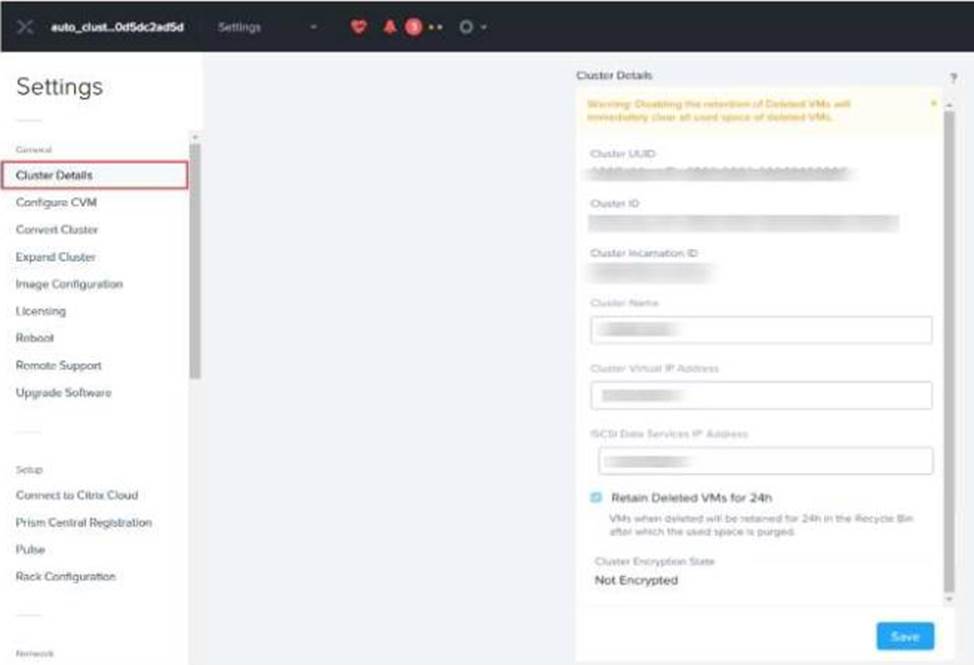Nutanix NCA-6.5 Nutanix Certified Associate (NCA) v6.5 exam Online Training
Nutanix NCA-6.5 Online Training
The questions for NCA-6.5 were last updated at Apr 21,2025.
- Exam Code: NCA-6.5
- Exam Name: Nutanix Certified Associate (NCA) v6.5 exam
- Certification Provider: Nutanix
- Latest update: Apr 21,2025
An administrator needs to do a manual VM in-place restore of a mission-critical VM.
Which Prism Central option should the administrator use to satisfy this task?
- A . Snapshot
- B . Clone
- C . Backup
- D . Recovery Point
D
Explanation:
A manual VM in-place restore can be performed using the Recovery Point option in Prism Central. This option enables an administrator to restore a VM to a previous state without needing to create a new VM.
Reference: https://portal.nutanix.com/page/documents/details?targetId=Prism-Admin-Guide-v5_6:pr-vms-backup-restore-c.html
How should an administrator enable the recycle bin on a nutanix cluster?
- A . Select the Enable Recycle Bin checkbox on the storage Overview page
- B . select Retain Deleted VMs for 8h in the cluster Details Page of the cluster setting
- C . Select the enable recycle bin checkbox in the configure CVM page of the cluster setting
- D . Select Retain Deleted VMs for 24h in the cluster details page of the cluster setting
D
Explanation:
Check the below.

Within a Nutanix cluster an administrator is getting frequent failure alerts of the Cassandra and Stargate services for one of the nodes.
What action will be taken by the cluster?
- A . Put host in Maintenance Mode
- B . Redirect I/O path to another CVM
- C . Remove the host from cluster
- D . Reboot Guest VMs to another hosts
B
Explanation:
The Nutanix distributed storage fabric (DSF) includes resiliency features designed to handle component failures such as disk, node, or block failures. Cassandra and Stargate are two critical services for data management in a Nutanix cluster. If these services fail on a node, DSF will automatically redirect the I/O path to another CVM (Controller Virtual Machine) to ensure no disruption to the running workloads and maintain the cluster’s stability and availability. This process is part of Nutanix’s self-healing mechanism.
Which address allows external connections to Nutanix storage presented by the Volumes feature?
- A . Prism Central IP
- B . Prism Central IP
- C . Data Services IP
- D . IPMI IP
C
Explanation:
The Data Services IP address is the address that allows external connections to Nutanix storage presented by the Volumes feature. This address is used to access the storage from external sources and is used for replication and external snapshotting.
Reference: https://portal.nutanix.com/page/documents/details?targetId=Prism-Admin-Guide-v5_6:pr-storage-storage-networks-c.html
An administrator has been tasked with delivering a report on all nutanix Field Advisors (FAs) Affecting each of the clusters.
What is the most efficient way to collect this data?
- A . Request an environmental audit from the Nutanix Support
- B . Use Prism to run NCC and Check for information on FAs
- C . Review the discoveries information on the support Portal
- D . Review Field Advisories published on the Support Portal
An administrator needs to upgrade AOS in a vSphere-based NutaniSJve-node cluster with no automatic live migration. VMs have neither affinity nor anti-affinity rules configured.
What will happen to VMs during the AOS upgrade?
- A . VMs will be rebooted on other hosts.
- B . VMs will continue to run on the same host.
- C . Upgrade fails because host can’t go in maintenance mode.
- D . AOS automatically live migrate VMs to other hosts.
C
Explanation:
In a vSphere-based Nutanix cluster, if there’s no automatic live migration configured and VMs have neither affinity nor anti-affinity rules, the AOS (Acropolis Operating System) upgrade process would require hosts to enter maintenance mode.
However, if a host cannot live migrate VMs to another host (due to the lack of automatic live migration), and there are still running VMs, the host cannot enter maintenance mode and therefore the upgrade process would fail.
An organization runs several core business applications on a Nutanix cluster. System stability and support are critical for these applications, which has an annual maintenance window.
How can the administrator assure that these requirements are met?
- A . Purchase Mission Critical support.
- B . Purchase Ultimate licensing.
- C . Adhere to the STS release cycle.
- D . Adhere to the LTS release cycle.
Assuming Sufficient Storage Capacity, how long are entities kept in the prism recycle bin?
- A . 8 hours
- B . 24 hours
- C . 1 week
- D . 1 month
An application owner had reported that an AHV-based critical application VM is performing very slowly. After initial diagnostics, it has been observed that the CPU utilization is significantly higher than normal.
What two actions should the administrator take on this VM without shutting it down? (Choose two.)
- A . Increase number of vCPU in Prism Element
- B . Configure additional cores in acli
- C . Ensure CPU hot-add is supported by the Guest
- D . Use PrismElement to increase the number of cores
Where can an administrator configure role-based access control (RBAC)?
- A . Self-Service Restore
- B . Prism Element
- C . Foundation
- D . Prism Central
D
Explanation:
Role-based access control (RBAC) allows administrators to configure access control for different users and groups in the Nutanix cluster. This feature is available through Prism Central, where administrators can configure roles and permissions for different users and groups.
Reference: https://portal.nutanix.com/page/documents/details?targetId=Platform-Administrator-Guide-v5_7:pag-user-role-c.html
Latest NCA-6.5 Dumps Valid Version with 98 Q&As
Latest And Valid Q&A | Instant Download | Once Fail, Full Refund

